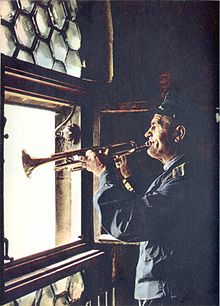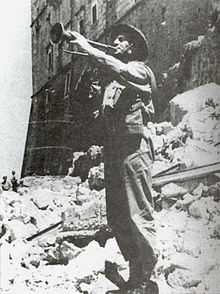- Hejnał mariacki
-
The Heynal (Polish: Hejnał Mariacki, "St. Mary's dawn", pronounced hey-now mah-ryah-tskee), also known as the Cracovian Hymn, is a traditional five-note Polish tune closely tied to the history and traditions of the city of Krakow. It is played by a trumpeter four times consecutively each hour from the highest tower of St. Mary's Church (in Polish, Kościół mariacki) in Krakow.
Contents
History
Origins
The real origin and author of the Heynal tune are unknown. The earliest written mention of it is in civic pay records from 1392. The word hejnał comes from hajnal, the Hungarian word for dawn. These two facts fit well with an origin under King Louis I "the Hungarian" (reigned in Poland 1370 – 1382) or his daughter Jadwiga, who was known as Jadwiga King of Poland (reigned 1384 – 1399). Bugle calls were used in many European cities to signal the opening and closing of city gates at dawn and dusk, respectively. The four directions in which the bugle call is currently made correspond roughly to the four main gates of Krakow before they were torn down in the 19th century. 16th century sources mention other buglers on other towers, and it is possible that the “interrupted” tune was originally meant to allow a second trumpeter on a gate to signal the completion of the task of opening or closing. Bugle calls from the Mariacki tower were also used to warn of fires and other dangers in historical times.
Legendary origins
According to a popular 20th century legend, during one of the Mongol invasion of Poland (usually the invasion of 1241), Tatar warriors approached the city. A guard on the Mariacki church tower sounded the alarm by playing the Heynal, and the city gates were closed before the Tatars could take the city by surprise. The bugler, however, was shot in the throat and did not complete the tune. According to the legend, that is why it now ends abruptly before completion.
The earliest written version of this legend is from the prologue to American Eric P. Kelly’s 1928 children’s book The Trumpeter of Krakow. Kelly, who was teaching at the Jagiellonian University on a scholar exchange 1925 – 1926, admitted that he did not speak Polish very well at the time that the story was composed, and relied on French-speaking friends to translate. Part of the current legend may come from a recent historical incident in which a trumpeter died of natural causes while on duty at midnight on July 7, 1901. A 1926 tourist guide rather vaguely claims that the death of a trumpeter is the reason for the sudden end of the tune, but doesn’t mention any Tartars or arrows. Another possible piece of the puzzle is Ludwik Anczyc’s 1861 version of the Lajkonik legend which describes a Mariacki guard spying the approaching Tartars and raising the alarm, but it does not mention any arrows or the death of the guard. It is possible that Kelly was simply the first to write down the full version of an existing Krakow legend that had escaped the many collectors of Krakow legends. It is also possible that he was the victim of a hoax or accidentally conflated two different stories. It is certainly remarkable that Professor Karol Estreicher, Jr.’s thorough 1931 guide to Krakow omits the story.
Whatever the origin of Kelly’s story, it proved to be popular in Krakow. The first written version of the full Tartar-arrow-and-bugler Heynal legend in Polish is from a 1935 tourist guide. The second appears in a fiction sequel by Ksawery Pruszyński (who was a student at the Jagiellonian University while Kelly was teaching and was later Estreicher’s assistant) entitled The Trumpeter of Samarkand which also ties in to the Lajkonik legend. After the Second World War, Kelly’s role in the legend was largely forgotten and the legend began to be passed down in true folk fashion.
Another recent tradition has it that the four directions in which the tune is played are in honor of the king (southwards towards Wawel Castle), the mayor/bishop (towards the City Hall/Bishop's Place on Kanonicza Street), the citizens (towards Main Market Square), and the peasants/guests (towards the fields outside Krakow/the Barbican of Krakow).
Later usage
Historical records show that the practice of playing the Heynal has been cancelled and then later reinstated several times in the past centuries. There was a longer gap before it was reinstated in 1810. The Heynal was traditionally played twice a day (usually dawn and dusk). Noon was added later. Today, the trumpeter plays live at all 24 hours in the day, although sleepy trumpeters are sometimes reported to have missed one of the early hours of the morning. Starting in 1927 and continuing to today, there is a live broadcast of the Heynal from the Mariacki church tower Krakow every day at noon on Polish national radio.
The Krakow Heynal has become well-known throughout Poland and has been used as a symbol of the Polish nation as a whole. For instance, during World War II, on May 18, 1944, a bugler from the 2nd Polish Corps played the tune to announce the Polish victory in the Battle of Monte Cassino.
On June 11, 2000, the melody was recorded in the Guinness Book of Records, after it was played by almost 2,000 trumpeters from all over the world. Among them were military orchestras from Poland, the UK, Belgium and Spain, as well as civilians. The youngest of the buglers was barely eight years old and the oldest 79.
On April 3, 2005, at midday, on the day following the death of Pope John Paul II, the Hejnał Mariacki was, for the first time in its history, replaced with the mourning song "Lzy Matki" (English: "The Tears of the Mother"). On April 11, 2010, at two minutes after noon, Lzy Matki replaced the Heynal for a second time, due to the death of Lech Kaczyński.[1]
Originally played by the town guard, since the 19th century the Heynal has been performed by active members of the fire brigade, who use the church tower as a lookout post. Currently there are at least four different buglers serving in rotation at the tower.
The longest serving trumpeter was Adolf Śmietana who played the Heynal for 36 years, starting in 1926. The Kołton family has played the Heynal for three generations. In October 2004, Jan Kołton retired after 33 years of service at the tower. His father had been a Heynal bugler for 35 years previously, and the tradition is currently continued by his son.
See also
- St. Mary's Church, Kraków
- Kraków
- Culture of Kraków
References
- Burek, Edward (ed.) “Hejnał mariacki” in Encyklopedia Krakowa. Krakow: PWM, 2000.
- Dobrzycki, Jerzy. Hejnał Krakowski. Krakow: PWM, 1983.
- Kelly, Eric P. “Papers, 1928-1964,” archive in the collection of Dartmouth Library
- Kelly, Eric P. The Trumpeter of Krakow, New York: The Macmillan Company, 1928.
- Zinków, Julian. Krakowskie i jurajskie podania, legendy, zwyczaje. Krakow: Wydawnictwo PLATAN, 1994.
Categories:- Culture of Kraków
- Polish culture
- National symbols of Poland
Wikimedia Foundation. 2010.



